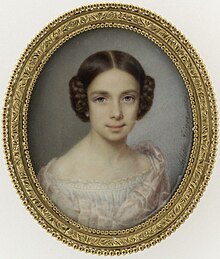Louise Filliaux-Tiger
Louise Filliaux-Tiger | |
|---|---|
 Filliaux-Tiger in c. 1897 | |
| Born | Louise Sophie Tiger 22 May 1848 Paris, France |
| Died | 28 November 1916 (aged 68) Nice, France |
| Occupations |
|
Louise Filliaux-Tiger (22 May 1848 – 28 November 1916) was a French pianist, composer and teacher of the late Romantic period. Born into an artistic family, Filliaux-Tiger attended the Conservatoire de Paris, spending her subsequent career in the city. As a successful performer and composer for piano, most of her works were for the instrument, although she wrote vocal and chamber music as well.
Life and career
[edit]
Louise Sophie Tiger was born on 22 May 1848 in the 8th arrondissement of Paris, France.[2][3] Her father was the architect Alexandre-Joseph-Jean-Baptiste Tiger, while her mother was the painter Félicie Tiger.[1] She entered the Conservatoire de Paris sometime before 1868.[1] Tiger's Conservatoire awards included 2nd runner-up (accessit) for harmony and accompaniment in 1868 and 2nd prize in the same category for 1869.[3] At some point she married Charles-Émile Filliaux, and combined their surnames.[1]
Filliaux-Tiger became an Officier d'Académie on 24 December 1885.[1][4] A member of both the Société nationale de musique and the International Society of Music, she was vice president of the Union of Women Music Teachers and Composers for a time.[1] She founded the Soirées confraternelles in 1897, annual concerts at the Salle Pleyel which featured the work of women composers.[4] She died suddenly on 28 November 1916 in Nice, France.[1] Her will included a bequest of 120,000 F to the French government, granted that it be used for performances of orchestral music by French woman composers.[1]
She was active as a pianist, composer and teacher.[4] Teaching from Paris,[1] the Dictionnaire national des contemporains describes her as a "renowned" pianist.[4] The latter source insists she was best known as a composer;[4] her compositions include mainly piano works, but also songs and chamber music.[1] Many of her works were distributed by the Société Coopérative des Compositeurs de Musique, but often published "at her own expense".[1] Among her best known works is a Ballade (1914), simultaneously published in both vocal and solo piano variants; a third version, with two additional voices, was published in 1915.[1] The vocal ensemble Para l'Elles noted the work's detailed instructions, and likened the atmospheric choral writing to that of Debussy and Ravel.[1]
After a period of neglect, Filliaux-Tiger was rediscovered by the research of composer Adélaïde Legras, in the Bibliothèque nationale de France archives, where many of her works are held.[1]
List of compositions
[edit]- Piano
- Deux Pièces Pastorales pour piano, 1890
- Dans les brandes, 1900
References
[edit]- ^ a b c d e f g h i j k l m n o "Louise Filliaux-Tiger". Présence Compositrices. Retrieved 2 March 2024.
- ^ "Archives reconstituées d'état civil de Paris, acte de naissance" [Reconstructed Civil Status Archives of Paris: Birth Certificate] (in French). p. 39. Retrieved 2 March 2024.
- ^ a b Pierre, Constant (1900). Le Conservatoire national de musique et de déclamation: Documents historiques et administratifs. Paris: Imprimerie Nationale. p. 859. OCLC 1048202170.
- ^ a b c d e f Curinier, C.E. (1914). Dictionnaire national des contemporains. Paris: Office Général d'Edition. p. 318. OCLC 697614752.
- ^ "Louise Filliaux-Tiger (1848 – 1916)". Les amis de Para L'Elles. 18 February 2021. Retrieved 2 March 2024.
External links
[edit]- Free scores by Louise Filliaux-Tiger at the International Music Score Library Project (IMSLP)
- Free scores by Louise Filliaux-Tiger in the Choral Public Domain Library (ChoralWiki)
- 1826 births
- 1859 deaths
- 19th-century classical composers
- 19th-century French women classical pianists
- 19th-century French classical pianists
- 19th-century French composers
- 20th-century classical composers
- 20th-century French women classical pianists
- 20th-century French classical pianists
- 20th-century French composers
- French women classical composers
- French music educators
- French Romantic composers
- Composers from Paris
- French women music educators
- 19th-century French women composers
- 20th-century French women composers
